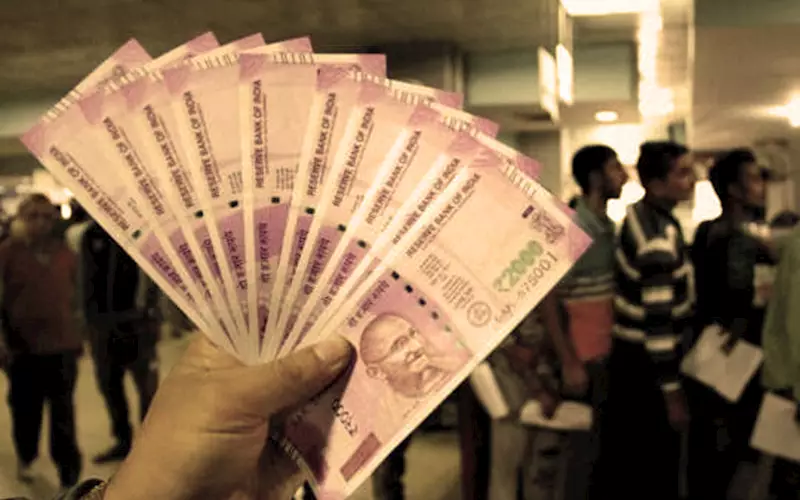133% jump in cost of printing currency notes
The Reserve Bank of India (RBI) spent a whopping Rs 7,965 crore to print new currency notes from July 2016 to June 2017, a jump of 133% against Rs 3,421 crore in the same period of the previous year, in the wake of demonetisation of Rs 500 and Rs 1,000 notes. According to the RBI, published in its Annual Report, the surge in expenditure during the year was on account of change in the production plan of printing presses due to the introduction of new design notes in higher denominations as well a
20 Sep 2017 | By Dibyajyoti Sarma
“Furthermore, in order to ensure availability of banknotes across the country at the shortest possible time subsequent to the demonetisation, banknotes had to be frequently air-lifted from the presses to the issue offices of the Reserve Bank as well as directly to currency chests wherever feasible, which partly contributed to the increase in the cost of distribution of banknotes,” the RBI said. The RBI introduced new Rs 500 and Rs 2,000 notes after demonetising old Rs 500 and Rs 1,000 notes on 8 November.
“In order to improve availability, direct remittances were increasingly sent to various currency chests from the printing presses. More than 100 direct remittances were sent to currency chests in various issue circles,” the RBI said. Banks managing the currency chests were allowed to make inter-circle diversions at their discretion to even out cash availability, it said. There was reimbursement of cost for finished banknotes, work in progress, raw materials, etc. as the printing presses had to discontinue printing of Rs 500 and Rs 1,000 denomination banknotes which were withdrawn in November 2016.
The total supply of notes was 3.5% higher than the indent placed with the printing presses for 2016-17, while the indent itself was higher by around 17.4% than that of the previous year, the RBI said.
As a result of the high cost incurred for printing notes as part of remonetisation of currency and provisions, the total expenditure of the Reserve Bank increased by 107.84% from Rs 14,990 crore in 2015-16 to Rs 31,155 crore in 2016-17, according to the RBI’s Annual Report.
Supply of notes during the year at 29,043 million pieces was 37% higher than the total supply during previous year (21,195 million pieces). Supply of higher denomination notes during 2016-17 was 13,702 million pieces as against 5,268 million pieces supplied in 2015-16, higher by 160%, the RBI said.
In its Right to Information (RTI) reply to an application filed by The Indian Express, the RBI had said the Central Board discussed and approved the proposal to introduce Rs 2,000 notes on May 19 last year.
Printing presses to RBI: Pay us Rs 577 crore for note-ban loss
The government’s currency paper printing presses have asked the Reserve Bank of India (RBI) for compensation or reimbursement to the tune of Rs 577 crore for what they estimate was the loss and wastage they had to incur due to demonetisation.
According to media reports, the matter was under discussion and since the printing presses were captive units — they do no commercial work — the losses they incurred would surely have to be offset.
The Rs 577-crore bill is largely on account of huge consignments of imported/indigenous currency note paper used for Rs 1,000 and Rs 500 denominations as well as consignments which had been previously ordered or were in the process of being shipped to India. Besides this, the printing presses are understood to have added cost of wasted ink and other materials used specifically for these denominations as well as the wasted cost of printing the sizeable stocks of currency notes lying in their establishments or being packed and transported — all being described as “work in progress” at the time of the dramatic announcement of demonetisation.
Jaitley defends printing cost of new bank notes
Finance minister Arun Jaitley said the high cost of printing new currency notes and a short-term blow to GDP growth weren’t compelling arguments against the government’s move to demonetise old high-value currency notes in November.
“When you say you spent money on printing of currency, you have a very narrow vision. Currency replacement takes place even in normal course. If you hadn’t been printing new currency but printing old currency. This is a kind of trifling argument,” Jaitley said during The Economist India Summit in New Delhi on 2 September 2017.
Jaitley said that in the long term, the Indian economy stood to gain from the move to invalidate old 500- and 1,000-rupee notes. “Even if in the short term you take a hit for a quarter or two, or three, as far as GDP is concerned, in the medium and long term, the economy stands to gain from integration of formal and informal economy,” Jaitley said.
Gang printing fake currency in Old Delhi busted
According to a report published in The Times of India, a gang printing fake currency from a house near Jama Masjid and circulating them in flea markets during the festive season has been busted. Cops found that the gang had also bought animals during Bakrid using the fake notes.
The kingpin used to be a supplier of fake currency notes, but later turned into a ‘printer’. Police have seized the printing presses and equipment used for copying the notes. The criminals were found printing notes of Rs 100 and Rs 500 denominations, which have a larger circulation.














 See All
See All